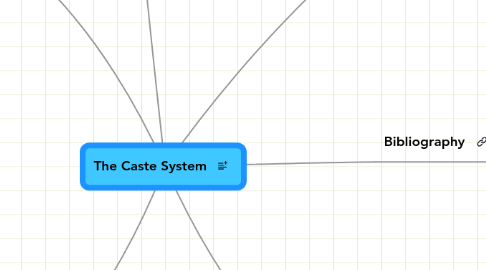
1. Non-Hindus
1.1. Anyone who religiously does not belong to any of the varnas is an outcast/ untouchable
1.1.1. Supposed to be untouchables
1.1.2. Not actually treated badly
1.1.3. Some tribes live in jungles of India
1.2. Christianity
1.2.1. Catholic
1.2.1.1. Dalit Catholics
1.2.1.2. Higher Catholics
1.2.1.2.1. Have more power over the churchs
1.2.2. Grouping goes by location and church administrative jobs
1.2.3. Treated differently in different parts of the country
1.3. Islam
1.3.1. Were powerful to the Hindus
1.3.1.1. Tried to convert Hindus
1.3.1.2. Once you converted you stayed in the same caste usually
1.3.2. Sections
1.3.2.1. Some are rivals
1.3.3. Ashrafs
1.3.3.1. Have a superior status because of their Arab ancestry
1.3.4. Ajlafs
1.3.4.1. Assumed as converts from Hinduism, therefore have lower status
1.3.5. Arzal
1.3.5.1. Equivalent to untouchables
1.4. Buddhism
1.4.1. Have something like the caste system
1.4.2. Criticized India Caste System
1.4.3. Developed in India
1.5. Judaism
1.5.1. In western India
1.5.2. Treated like untouchables
1.5.3. Three main communities
1.5.3.1. Bene Israel
1.5.3.2. Cochini Jews
1.5.3.3. Baghdadis
1.6. Sikhism and Jainism
1.6.1. Have traces of Caste System but Sikhism rejects it
1.6.2. Believe in equality
2. Occupations
2.1. Brahmans
2.1.1. Priests
2.1.2. Scholars
2.1.3. Intellectuals
2.2. Kshatriyas
2.2.1. Goverenment
2.2.2. Rulers
2.2.3. Military
2.3. Vaisyas
2.3.1. Merchants
2.3.2. Trainers
2.3.3. Farmers
2.4. Sudras
2.4.1. Peasants bound to the land.
2.5. Rules of Occupations
2.5.1. Women forced to marry inside the caste so that the tradition kept going
2.5.2. Occupations passed down from father to son
2.5.3. One was always guranteed a spot in the castes, but could never climb up to a higher caste.
3. Untouchables
3.1. The outcasts of the caste system
3.1.1. They are too dirty to touch the cleanliness of the higher Varnas
3.2. Jobs
3.2.1. Unclean, polluting jobs
3.2.1.1. worked nights and stayed in during the day
3.2.2. Example: working at a factory; or dump; or eating, meat and occupation involving meat
3.3. Restrictions
3.3.1. No contact with orthodox hindus
3.3.1.1. If they come in contact, the person of that varna must be cleansed. (twice born)
3.3.1.2. If anything was touched in a house or temple it must be washed immediately
3.3.2. Not allowed to enter the home or temple of the different, higher varnas
3.3.3. No rights in society
3.3.4. Not allowed to take water from the same well
3.4. Consequence for interacting with the other varnas is death or serious beatin
3.5. Most converted to Islam, Buddhism and Christianity because of the discrimination
3.6. Ghandi changed name to Harijans "Children of God"
3.6.1. Then changed to Dalit- meaning depressed
4. Beginning of Caste System
4.1. Theories
4.1.1. Religious
4.1.1.1. Explains the creation of the four varnas, however not how they were founded
4.1.1.2. The order of the organs is the order of the society, Brain to feet.
4.1.2. Biological
4.1.2.1. Diet and Food
4.1.2.2. Inherit qualities
4.1.2.2.1. Good
4.1.2.2.2. Bad
4.2. Aryan Rule
4.2.1. Aryans entered at about 1500 BC from Northern Asia an Europe.
4.2.1.1. As a result, they pushed all the locals out
4.2.2. Divided into three varnas
4.2.2.1. Rajayana
4.2.2.2. Brahmans
4.2.2.3. Vaisia
4.2.2.4. Sudra Varna was in between outcasts and Varnas, they were the simple workers of society
4.2.3. Made new rules, Varnas
4.2.3.1. Could only be a businessman, priest, or warrior
4.2.3.2. Anything else was outcasted
4.2.3.3. Inherit professions
4.2.3.3.1. Jat.- in Indian
4.2.4. Non- Aryan rule
4.2.4.1. Anyone who conquered India (Greeks and Huns), would fit into the Sudra Castes and not the original three.
4.2.4.2. polluting jobs were in the outcasts
4.2.4.3. non-polluting jobs were in the Sudra Caste
4.3. Hindu rule
4.3.1. Adopted it into their own religion
4.3.1.1. Thought that if they upheld their caste, then they would get to know God.
4.3.1.2. Everything that went into the system had to be related to the Vedas
4.3.2. Helped maintain the structure of the Caste System
4.3.2.1. Reincarnation
4.3.2.2. Cycle of Birth
4.3.2.3. Maintained purity
4.3.3. The world would not function in the way God wanted it to, if any outsider came into the caste.
5. Modern Caste System
5.1. Democratic, socialist, and secular country
5.1.1. "burn hatred, not children"
5.2. Untouchability is forbidden
5.2.1. Only positive discrimination is allowed
5.2.2. Caste is used instead of Varna or Jat
5.3. More flexible about mingling castes in most places
5.3.1. takes time to move into the higher castes.
5.3.2. must start behaving like them to try and get into the higher caste
5.3.3. have to work to become what you want, you don't always have to be born into it
5.4. Higher Castes
5.4.1. Still discriminate negatively
5.5. Lower Castes
5.5.1. Three catergories
5.5.1.1. Scheduled Castes
5.5.1.1.1. Consist of unotuchables even thought eh untouchables don't exist that much anymore
5.5.1.1.2. Dalit- meaning depressed
5.5.1.2. Scheduled Tribes
5.5.1.2.1. Also called aborginals
5.5.1.2.2. Don't except the caste system and live in the jungles and forests of India
5.5.1.3. Backward Classes
5.5.1.3.1. People of the Sudra Varna
5.5.1.3.2. Criminals
5.5.2. Positive Discrimination policy
5.5.2.1. Different for each government state
5.5.2.2. Different communities get different figures of positive discrimination
5.5.2.3. Created new tensions
5.5.2.3.1. Higher Castes felt discriminated because they had to reserve spots for the backwards classes
5.5.2.3.2. Backwards classes were given spot even if they weren't worthy, just to fill the quota
5.5.2.3.3. Identity structure
5.5.3. In the Rural area, they are still treated like untouchables
5.5.3.1. They are put on the east because the wind blows west to east and the higher castes don't want to be contaminated by the lower castes.
